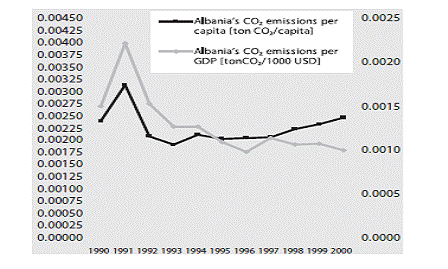Published: 30 Nov 2010
Modified: 17 Feb 2025
The Albanian Government became part of the United Nations Framework Convention on Climate Change (UNFCCC) in 1995 and ratified the Kyoto Protocol in 2004, so acknowledging the importance of climate change and the need to take effective measures to mitigate its consequences.
Levels of greenhouse gas (GHG) emissions in Albania are about four to five times lower than average international levels. This is because a high percentage of electricity is produced by hydropower, but also because energy consumption per person is low and industrial productivity has continued to fall.
Direct Greenhouse Gas Emissions
This section provides an overview of GHG emissions for the period 1990-2000. The figures below show emissions of the most important GHGs, carbon dioxide (CO2) and methane (CH4) from the six main economic sectors, recommended by the Intergovernmental Panel for Climate Change (IPCC): energy, including all types of activity related to extraction, transportation, processing and combustion of fossil fuels; industrial processes; solvent and other product use; agriculture; land-use change and forestry; and waste.
Figure 1. CH4 emissions by economic sectors (%) Figure 2. CO2 emissions by economic sectors (%)
As shown in Figure 1, the main contributor of CH4 emissions is agriculture (74-77 %), followed by waste (8-22 %) and energy (5-20%).
As shown in Figure 2 the main contributor of CO2 is the energy sector (44–79 %) followed by land-use change and forestry which contributed 33 % in 1990 but just 16 % in 2000. Industrial processes contributed 2.6-4.9 % while CO2 emissions from the waste, solvents and agriculture sectors were not significant.

Figure 3. CO2 emissions per person (tonne/person) and CO2 emissions per GDP (tonne.US1 000).
Figure 3 shows trends of CO2 emissions per person and per US$ 1 000 of GDP. Emissions per person have increased, reflecting increased energy consumption resulting from increased standards of living, while emissions per US$1 000 of GDP have fallen.
Figure 4. Population and CO2 emissions per person
Total greenhouse gas emission scenarios
Climate change policy is developed through national communications that deal separately with mitigation of GHG emissions and adaptation to climate change. Analysis has been carried out for each economic sector, scenarios for the future have been constructed, and measures have been proposed for mitigating and adapting to expected climate change.
Two scenarios have been constructed for all the analyzed sectors: the baseline scenario and the abatement scenario. The former considers the development of sectors without taking account of the effect of climate change, while the latter assumes implementation of a set of prioritised measures aimed at reducing emissions by 48 % by 2025 compared with the baseline scenario.
Figure 5. GHG emissions according to the baseline and abatement scenarios for 2010-2025 [Gg CO2 eq]
Policy context
The main political documents that address climate change issues are:
• National Strategy for Development and Integration (2007-2013)
• Intersectorial Environmental Strategy 2007-2013
• First National Communication for UNFCCC
• Second National Communication for UNFCCC
• Policy document of Carbon Financing in Albania, 2009
• Plan of action for the implementation of the Policy Document for Carbon Financing in Albania
According to the Intersectorial Environment Strategy, the main focus for climate change is to improve energy efficiency in all sectors in order to reduce the demand for power and the level of emissions. The strategy also requires a joint programme of public awareness and enforcement of relevant standards – such as for the insulation of buildings.
The strongest instrument for reducing the amount of gases emitted is the integration of the GHG emissions reduction target in the decision-making process at a variety of levels:
• government – in particular strategies for energy, the economy and transportation should include steps to limit the GHG emissions;
• industry and trade – should be encouraged to be efficient from the standpoint of energy consumption and technology used in order to reduce the level of emissions;
• individuals – must be convinced to see energy efficiency as a criterion in their actions and purchases.
These measures need to be accompanied by changes in the legal framework and the introduction of economic instruments to promote the reduction of GHG emissions and the use of renewable energy sources.
The measures envisaged by the Intersectorial Environmental Strategy to mitigate climate change include:
Change of legal basis:
- legal framework for energy efficiency in new buildings;
- legal framework for energy efficiency of household equipment .
Establishment of economic incentives:
- setting the carbon tax;
- creation of a grants or subsidy scheme for energy efficiency.
Reduce GHGs released by transport and energy:
- review of the transport strategy in accordance with the provisions of the strategic environmental assessment for the improvement of road transport infrastructure;
- introduction of vehicles with low levels of emissions;
- review the strategy for the energy sector in accordance with the provisions of the strategic environmental assessment to enable the promotion of renewable energy sources.
Awareness campaign to reduce the amount of greenhouse gases:
- promotion of energy efficiency in industry;
- improvement of thermal insulation and reducing unnecessary use of power for heating or cooling systems in houses;
- promotion of solar heating systems.
References:
- National Environment Strategy 2006, Ministry of Environment, Forests and Water Administration
- Intersectorial Environment Strategy 2007, Ministry of Environment, Forests and Water Administration
- Second National Communication of Republic of Albania adressed United Nations Framework Convention on Climate Change 2009, Ministry of Environment, Forests and Water Administration, UNDP




![Figure 5. GHG emissions according to the baseline and abatement scenarios for 2010-2025 [Gg CO2 eq] Figure 5. GHG emissions according to the baseline and abatement scenarios for 2010-2025 [Gg CO2 eq]](https://www.eea.europa.eu/soer/2010/countries/al/climate-change-mitigation-state-and/Figure5.jpeg/image_large)
Document Actions
Share with others